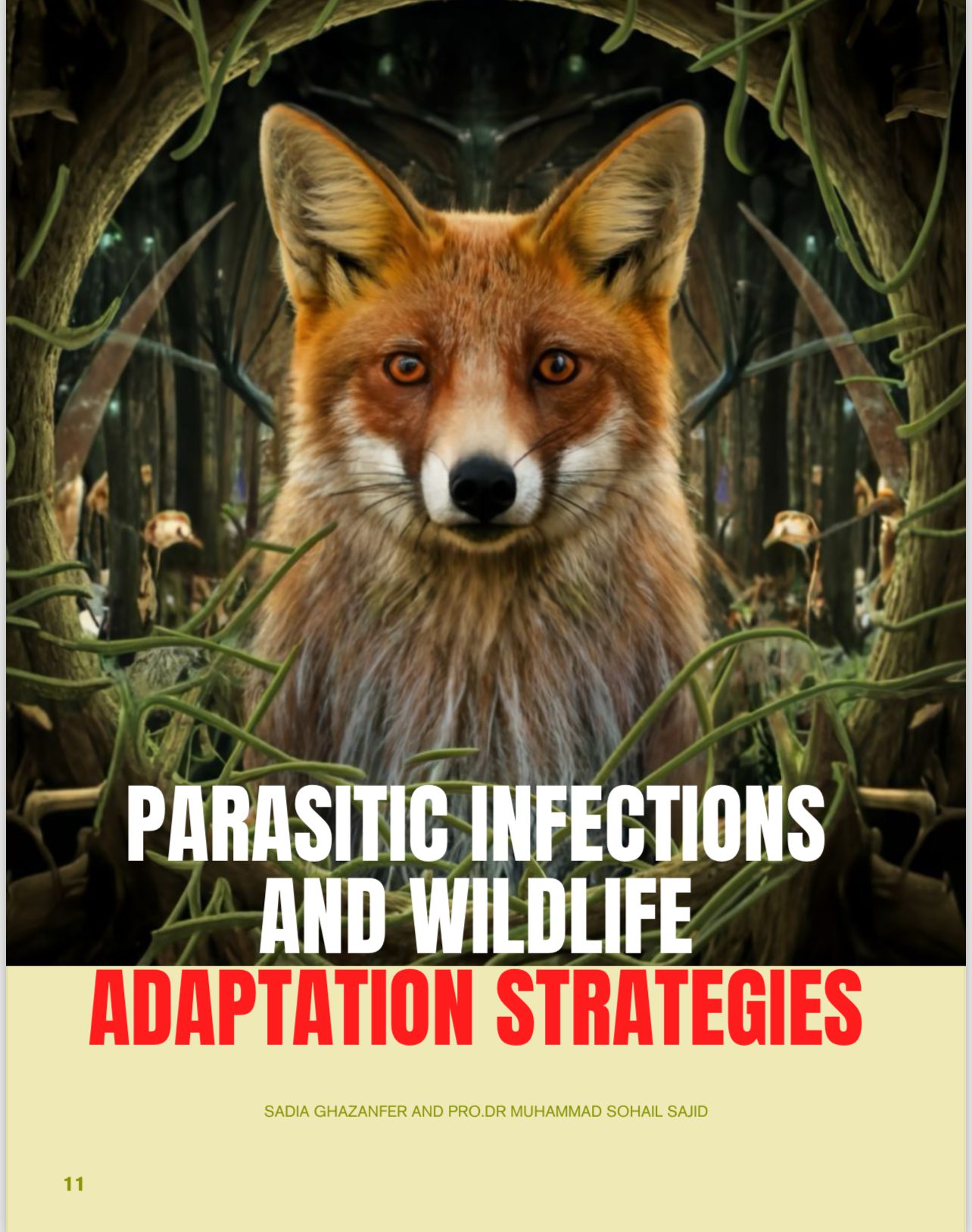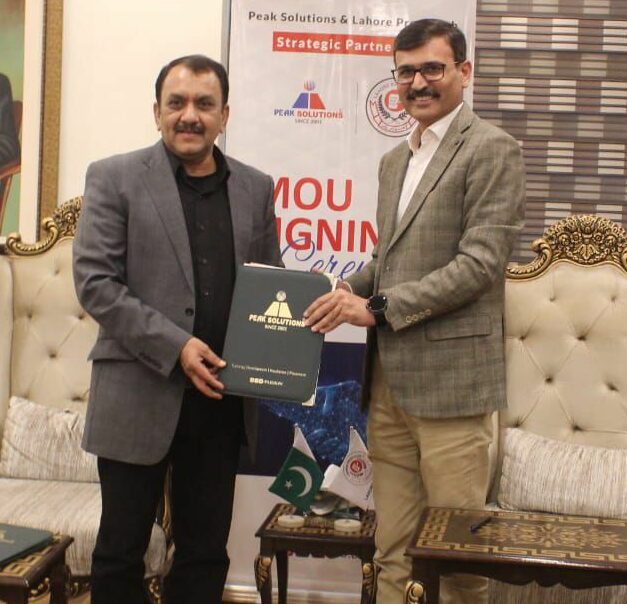By SADIA GHAZANFER AND PRO.DR MUHAMMAD SOHAIL SAJID
Parasitic infections are illnesses caused by tiny organisms called parasites. These parasites live in or on other organisms, known as hosts, and often
cause harm or sickness. They can be found in various parts of the body, like the intestines, blood, or tissues. Examples of parasites include tapeworms, which live in the intestines and steal nutrients, and blood
flukes, which can cause serious diseases. Wildlife refers to animals that live and thrive in their natural habitats, such as forests, oceans, and grasslands. It encompasses a wide variety of species, from majestic
elephants to tiny insects, each playing a unique role in their ecosystems.
Wildlife faces numerous challenges, including habitat loss, climate change, and interactions with humans. When it comes to parasitic infections and wildlife, there’s a complex relationship. Parasites can affect wildlife in many ways, causing illness, reducing populations, and even leading to extinction in some cases. Wildlife, in turn, can also influence the spread
and survival of parasites. For example, certain behaviors of wild animals, like migration patterns or social interactions, can impact the transmission of parasites within populations. Understanding the dynamics between parasitic infections and wildlife is crucial for conservation efforts and public health. By studying how parasites affect wildlife and how wildlife
respond to parasitic infections, scientists can develop strategies to protect both animal populations and human health. This knowledge helps in managing ecosystems, controlling disease outbreaks, and preserving biodiversity for future generations In the animal world, there’s a hidden battle happening all the time wildlife faces a big problem with tiny creatures called parasites. These little invaders, like gut worms and blood flukes, want to live off their hosts and make them sick. But animals have clever ways to fight back. Parasites have tricky methods to live inside their hosts. Tapeworms stick to the intestines and steal important nutrients. Filarial worms go into the lymphatic system, causing damage and swelling.
Hookworms have sharp mouthparts to drink blood. Each parasite is different, so animals have to find unique ways to protect themselves. Lots of animals try to stay away from parasites. Some birds, like swallows, can sense the magnetic fields from bugs that suck blood. This helps them avoid places with lots of parasites. Monkeys and apes use their hands and eyes to carefully groom each other, getting rid of ticks and other bugs before they can bite. And some animals make smelly or toxic substances that keep parasites away. In the battle between hosts and parasites,
animals are always adapting. They have to be clever to survive against these tiny attackers. By avoiding them and finding ways to fight back, animals keep on thriving in the wild. Managing parasitic infections is
crucial for wildlife preservation as these infections can significantly impact the health and stability of wildlife populations and ecosystems. Effective management strategies aim to minimize the negative effects of parasitic infections while promoting the resilience and sustainability of wildlife communities. One key approach to managing parasitic infections is through habitat conservation and restoration. By preserving natural habitats and minimizing human-induced disturbances, wildlife populations can maintain healthy immune systems and natural behaviors, which can help them better resist and tolerate parasitic infections. Furthermore, restoring degraded habitats can enhance biodiversity and provide opportunities for natural regulation of parasite populations by promoting diverse wildlife communities and ecosystem processes. In addition to
habitat management, targeted interventions may be necessary to control parasitic infections in wildlife populations. This may include the use of pesticides or vaccines to reduce parasite burdens in susceptible species, especially in cases where parasitic infections pose significant threats to endangered or vulnerable populations.
However, such interventions must be carefully designed to minimize unintended consequences and avoid negative impacts on non-target species or the environment. Methodological approaches for studying
wildlife parasites and adaptation play a crucial role in understanding the intricate dynamics between parasitic infections and wildlife populations. Scientists employ a variety of techniques to investigate the prevalence, transmission dynamics, and impact of parasitic infections on wildlife communities. One common method involves the collection and analysis of biological samples, such as blood, feces, or tissue samples, to identify and
12 quantify parasite species and their genetic diversity within host populations. Molecular techniques, including polymerase chain reaction (PCR) and DNA sequencing, allow researchers to characterize parasite
genomes and track their evolutionary adaptations to host defenses.
Furthermore, field studies and observational research provide valuable insights into the behavioral and ecological responses of wildlife species to parasitic infections. By monitoring host-parasite interactions in natural environments, scientists can identify adaptation strategies employed by wildlife to mitigate the effects of parasitic infections, such as changes in
behavior, habitat use, or immune responses. Integration of advanced technologies, such as satellite tracking and remote sensing, also enables researchers to assess spatial and temporal patterns of parasite distribution and transmission across different landscapes. By combining diverse methodological approaches, scientists can gain a comprehensive
understanding of the complex interactions between wildlife parasites and adaptation strategies, informing effective conservation and management efforts to safeguard both wildlife and ecosystem health.
In conclusion, managing parasitic infections in wildlife requires a multifaceted approach that integrates scientific research, conservation
efforts, and community engagement. Through our exploration of the impacts of parasitic infections on wildlife communities and adaptation strategies employed by hosts, several key insights and future directions emerge. there is a need for continued research to enhance our understanding of the mechanisms driving host-parasite interactions and
the factors influencing parasite transmission dynamics. Advanced methodologies, including molecular techniques, ecological modeling, and
remote sensing technologies, offer promising avenues for investigating the complex dynamics of parasitic infections in wildlife across different spatial and temporal scales. Furthermore, conservation efforts aimed at habitat preservation, disease monitoring, and captive breeding programs are essential for mitigating the impacts of parasitic infections on endangered or vulnerable wildlife populations. Collaborative approaches that involve partnerships between scientists, policymakers, local communities, and conservation organizations are vital for implementing effective management strategies and addressing emerging challenges posed by parasitic infections in wildlife. Education and outreach initiatives aimed at raising awareness about the importance of wildlife health and the role of parasitic infections in ecosystem dynamics are also critical for fostering public support and engagement in conservation efforts. By integrating scientific research with practical conservation actions and fostering
interdisciplinary collaborations, we can enhance our ability to manage parasitic infections in wildlife and safeguard the health and integrity of ecosystems for future generations. Through collective efforts, we can
ensure the continued survival and well-being of wildlife populations in a
changing world.
Sadia Ghazanfer and Pro.Dr
Muhammad Sohail Sajid
Department of Parasitology,
University of Agriculture, Faisalabad
Author can be reached at
sadiaghazanfar90@gmail.com





